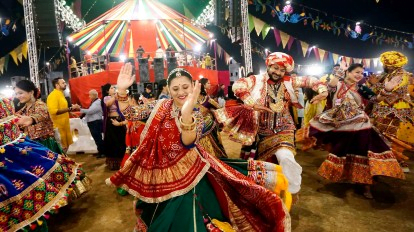Priyanshi Pareek reports on the latest addition of Garba in the UNESCO Heritage list..
Today, UNESCO approved the inclusion of garba, Gujarat’s most popular folk dance form, in its Representative List of Intangible Cultural Heritage (ICH) of Humanity. A decision to “inscribe” the dance form as “intangible heritage” was taken at the 18th session of the UNESCO’s Intergovernmental Committee for Safeguarding of Intangible Cultural Heritage of Humanity taking place in Kasane, Botswana from 5 to 9 December 2023.
The inclusion of Garba now makes it India’s 15th inscription on the List.
A ritualistic and devotional dance, holds a significant place in Gujarat and across India, particularly during the nine-day festival of Navaratri. This vibrant celebration venerates the feminine energy, known as Shakti. The dance serves as a cultural emblem, expressing the essence of this feminine energy through captivating performances. Garba is not confined to homes or temple courtyards but spills into public spaces like village squares, urban streets, and expansive open grounds, uniting communities in a collective celebration.
“I offer my sincere congratulations to India, its people and the teams that worked on the nomination dossier. I hope this inscription helps ensure the viability of this tradition and inspires the community, particularly young people, to continue with the knowledge, skills and oral traditions associated with Garba.”
Tim Curtis
Director of UNESCO New Delhi Regional Office for South Asia and UNESCO Representative for Bhutan, India, the Maldives, and Sri Lanka
Garba has become a vital part of Gujarati culture, resonating not just in India but globally among the Indian diaspora. Beyond its religious roots, Garba serves as a unifying force, breaking barriers of socio-economic status, gender, and sects, fostering social equality. Its inclusive spirit encourages participation from diverse communities, strengthening communal ties.
Botswana hosts the 18th session of the Intergovernmental Committee evaluating submissions for UNESCO’s lists. This includes 45 elements for the Representative List of Intangible Cultural Heritage, 6 for Urgent Safeguarding, 4 for Good Safeguarding Practices, and 1 International Assistance request.
Among the newly inscribed elements, besides ‘Garba of Gujarat,’ are Rickshaws and Rickshaw Painting in Dhaka (Bangladesh), Songkran (Thailand’s traditional New Year festival), Hiragasy (a performing art from Madagascar’s Central Highlands), Junkanoo (from the Bahamas), and the Procession and Celebrations of Prophet Mohammed’s Birthday in Sudan, among others.
The Representative List under the 2003 UNESCO Convention for the Safeguarding of Intangible Cultural Heritage currently comprises 704 elements spanning 5 regions and 143 countries. It showcases diverse expressions of intangible heritage, emphasizing its significance and promoting awareness. UNESCO’s goal is to preserve global communities’ cultural practices and expertise, ensuring the safeguarding of intangible cultural heritage worldwide.


